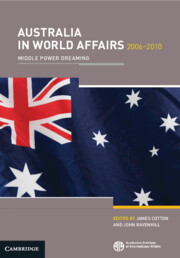347 results
14 - Defence and Security
-
-
- Book:
- Australia in World Affairs 2006–2010
- Published online:
- 04 May 2024, pp 211-225
-
- Chapter
- Export citation
4 - Australia and Asia: A View From Europe
-
-
- Book:
- Australia in World Affairs 1991–1995
- Published online:
- 04 May 2024, pp 33-43
-
- Chapter
- Export citation
13 - The Australia 2020 Summit as an Experiment in Foreign Policy-making
-
-
- Book:
- Australia in World Affairs 2006–2010
- Published online:
- 04 May 2024, pp 193-210
-
- Chapter
- Export citation
10 - Australia and Southeast Asia
-
-
- Book:
- Australia in World Affairs 1991–1995
- Published online:
- 04 May 2024, pp 108-122
-
- Chapter
- Export citation
9 - Security, Defence, and Terrorism
- from Part 3 - Issues
-
-
- Book:
- Australia in World Affairs 2001–2005
- Published online:
- 04 May 2024, pp 147-162
-
- Chapter
- Export citation
16 - Regional, Alliance and Global Priorities of the Rudd–Gillard Governments
-
-
- Book:
- Australia in World Affairs 2006–2010
- Published online:
- 04 May 2024, pp 237-251
-
- Chapter
- Export citation
6 - Australia and Japan: Mobilising the Bilateral Relationship
-
-
- Book:
- Australia in World Affairs 2006–2010
- Published online:
- 04 May 2024, pp 82-95
-
- Chapter
- Export citation

Australia in World Affairs 2006–2010
- Middle Power Dreaming
-
- Published online:
- 04 May 2024
2 - An Overview
- from Part I - Setting the Scene
-
-
- Book:
- Australia in World Affairs 1996–2000
- Published online:
- 04 May 2024, pp 8-22
-
- Chapter
- Export citation
4 - Australia–America 2006–2010: Waiting for Obama
-
-
- Book:
- Australia in World Affairs 2006–2010
- Published online:
- 04 May 2024, pp 46-61
-
- Chapter
- Export citation
15 - Australia’s Foreign Policy Machinery
-
-
- Book:
- Australia in World Affairs 2006–2010
- Published online:
- 04 May 2024, pp 226-236
-
- Chapter
- Export citation
11 - Facing an Uncertain Future: Defence and Security under the Howard Government
- from Part III - Issues
-
-
- Book:
- Australia in World Affairs 1996–2000
- Published online:
- 04 May 2024, pp 137-148
-
- Chapter
- Export citation
Secrecy games, power, and resistance in global politics
-
- Journal:
- Review of International Studies , First View
- Published online by Cambridge University Press:
- 22 April 2024, pp. 1-18
-
- Article
-
- You have access
- Open access
- HTML
- Export citation
3 - ‘To Give Law to the World’
-
- Book:
- Menacing Tides
- Published online:
- 11 April 2024
- Print publication:
- 18 April 2024, pp 108-166
-
- Chapter
- Export citation
Conclusion
-
- Book:
- Menacing Tides
- Published online:
- 11 April 2024
- Print publication:
- 18 April 2024, pp 293-307
-
- Chapter
- Export citation
4 - ‘No Security, Except in Destruction’
-
- Book:
- Menacing Tides
- Published online:
- 11 April 2024
- Print publication:
- 18 April 2024, pp 167-239
-
- Chapter
- Export citation
5 - Beyond the Littoral
-
- Book:
- Menacing Tides
- Published online:
- 11 April 2024
- Print publication:
- 18 April 2024, pp 240-292
-
- Chapter
- Export citation
Introduction
-
- Book:
- Menacing Tides
- Published online:
- 11 April 2024
- Print publication:
- 18 April 2024, pp 1-24
-
- Chapter
- Export citation
Chapter 8 - Security and Other Nonmedical Logistical Support Issues at Mass Gathering Events
-
-
- Book:
- Mass Gathering Medicine
- Published online:
- 11 April 2024
- Print publication:
- 18 April 2024, pp 97-104
-
- Chapter
- Export citation
‘We’ instead of ‘me’: How Buen Vivir Indigenous cosmopraxes allow us to conceive security differently and face insecurities together
-
- Journal:
- European Journal of International Security , First View
- Published online by Cambridge University Press:
- 15 April 2024, pp. 1-17
-
- Article
-
- You have access
- Open access
- HTML
- Export citation



